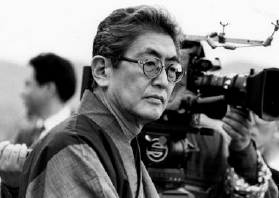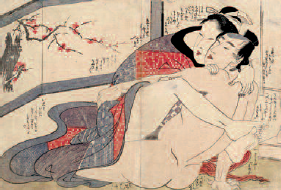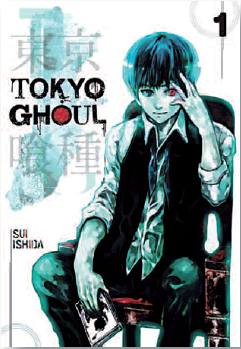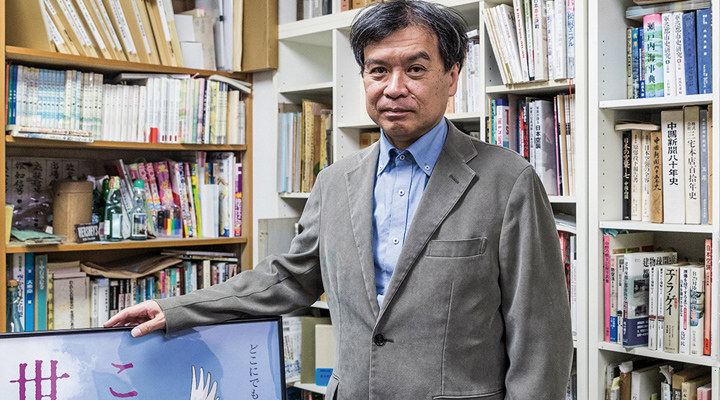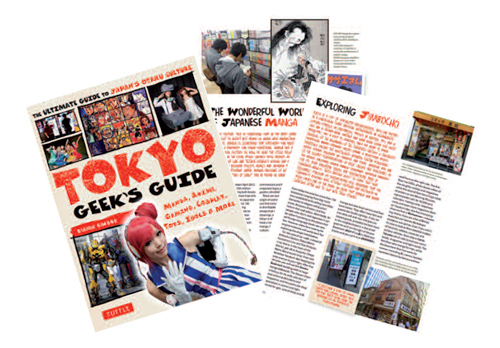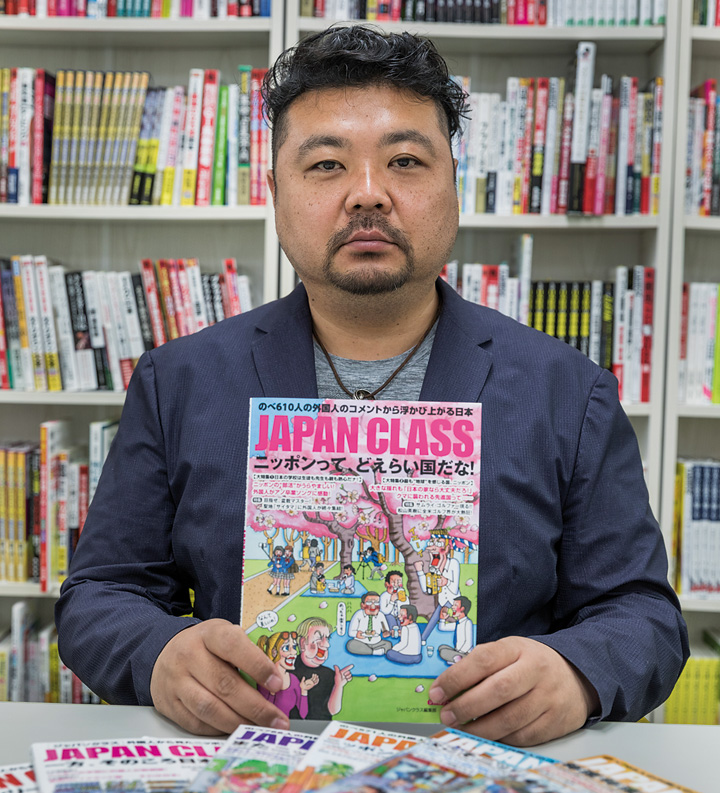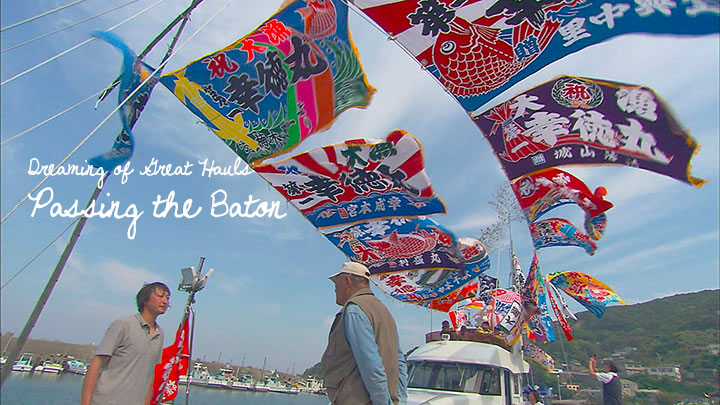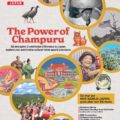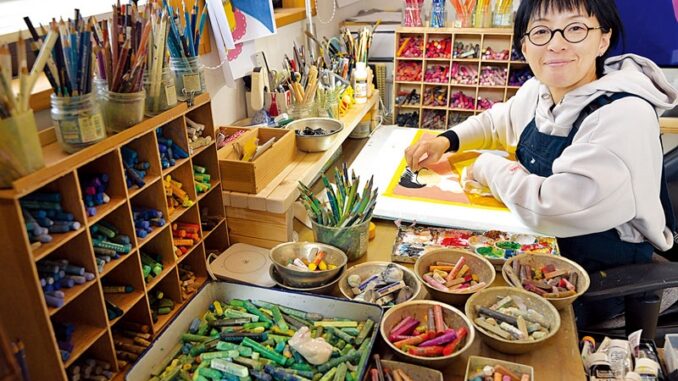
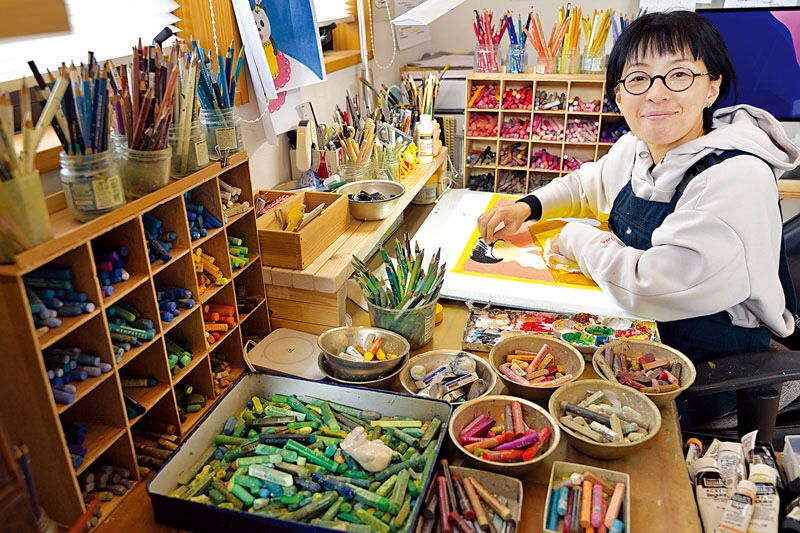
Born in the prefecture, Shibata Keiko found the resources and inspiration for her successful work there.
Kochi Prefecture has the highest percentage of forest area among Japan’s 47 prefectures – 84% – and its few areas of coastal plain are intensely cultivated. It only takes a short taxi ride from Kochi City to reach the countryside, and it’s here, in Harunocho, surrounded by a sea of greenhouses, that Shibata Keiko’s house and studio are.
Although Shibata-san has spent almost her entire life in Kochi, she is a nationally famous author of picture books whose whimsical stories enjoy both commercial and critical success: her second work, Oishisona shirokuma (Delicious Looking Polar Bear) won several picture book competitions, including the 8th Libro Picture Book Award, while Pan dorobo (Bread Thief) won both the 1st TSUTAYA Picture Book Award and the 11th Libro Picture Book Award.
After being shown into Shibata’s studio, we exchange business cards as is customary in Japan. On the reverse of her meishi, a girl has had the unwise idea of eating an ice cream on an extremely windy day. In the picture, the girl’s face is completely covered in vanilla ice cream, her blond-red hair waving like a flag. The drawing – part of a series about the wind – is typical of Shibata’s unconventional sense of humour.
Her work desk, overflowing with art supplies, takes pride of place in her cozy studio. “Oil pastels are my favourites,” she says. “I use products from quite a few different companies.” Greens abound in her colour palette. “Yes, I like green,” she admits. “After all, I like drawing nature. I also use regular coloured pencils quite a lot. Most of them are from foreign manufacturers.” She shows me how she works. She puts a new sheet of paper on a light box, draws a picture and starts colouring in with crayons. “The light box is also convenient for tracing,” she says.
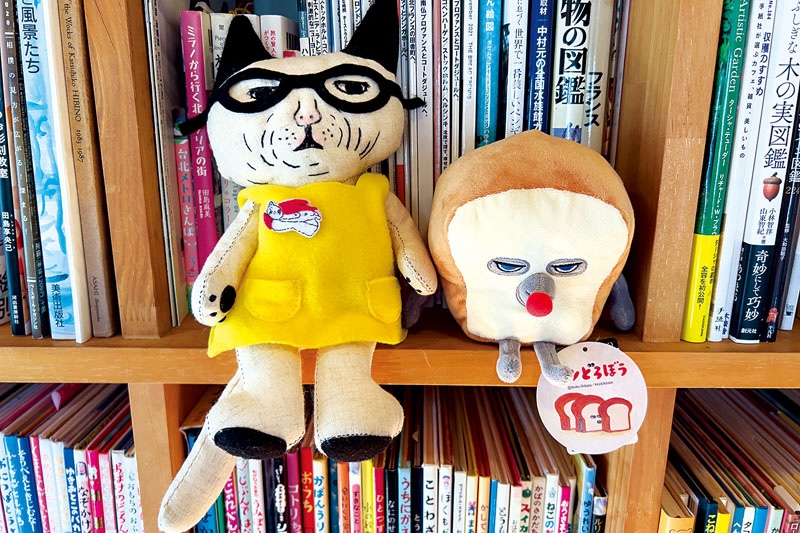
Shibata has lived in Harunocho for the last 15 years. “I don’t really like messy, crowded places,” she says. “Here is a little out of the way, but depending on how you look at it, it’s not so far from the city centre. It’s not too rural either. About five years after we got married, we found a good piece of land in a nice location, so we built our house here. The main thing is that I wanted to create in a quiet place, even if it was a little inconvenient.”
Shibata has been to Tokyo many times to meet her editors and publishers, but admits she could never live there. “Luckily, I don’t have to, thanks to the internet,” she says. “I always send my illustrations by email. I scan them, convert them into data and send them to my client. Picture books are a different story. I want the printed pages to be faithful to the colours of the original drawings, so I always send the originals by courier. Because colour is important.”
Shibata says that her living environment influenced the kind of artist she later became. “I think the fact that I love drawing nature and animals has something to do with growing up in Kochi. I’m not good at drawing buildings, but I find nature quite easy to do. Kochi has just the right balance of natural features – mountains and rivers, and the sea, of course. It’s the ideal environment to grow up in as a child. Also, the food in Kochi is delicious, that’s probably why many of my books have some sort of food theme.”
Talking about inspiration, Shibata says that illustrations and book art work in a different way. “With illustrations, I find that other people’s work is a great source of ideas. Going to a museum or the movies also helps. However, when it comes to picture books, I have to come up with a story. In that case, a lot of ideas are born out of my everyday life, like when I’m cooking. I go for a little run or walk every morning, and that’s when I get my inspiration.”
All these elements came together when she created her first book, Meganeko (The Glasses Wearing Cat, 2016), the story of a cat who owns a shop selling glasses in the forest and finds the right pair of glasses for each client according to their lifestyle and preferences. “I have two sons,” she says. “The first one was born in 2005 and the second in 2007. When my eldest son was still a baby, he was often agitated at bedtime and couldn’t sleep well, so I started reading to him, hoping that he’d fall asleep. Eventually, it became a habit, and I came to cherish the time spent with my son sitting on my lap, looking together at those colourful pages.”
Around this time, Shibata’s illustration work also began to increase, but since her workplace is also her home, she worked while taking care of her children. “I managed to do it because when my eldest son was eighteen months old I sent him to a daycare centre. “Then, when he was about to turn 4, I noticed something weird about his behaviour. He’d read picture books upside down, watch TV up close, and fall over often. So I took him to an eye doctor who diagnosed him with amblyopia.”
Amblyopia is an eye and visual system disorder that affects 5% of children, in which the brain fails to fully process input from one eye and over time favours the other eye. Their ability to see clearly is hindered depending on the individual, by farsightedness, astigmatism, strabismus, injury, etc. The main effect is a common deficit in visual acuity, not recognizable by parents, and needs a specialized eye examination. On the other hand, it’s said that there’s a high possibility of improvement if treatment is started in early childhood when visual acuity is developing. “It wasn’t detected during my 3-year-old’s checkup,” Shibata says. “I was shocked.”
One day, while at the doctor’s surgery where her son was being treated, he was given a picture book. “He was already wearing glasses at that time,” Shibata says, “and I found myself thinking, why aren’t there stories about glasses? I saw my son’s friends at nursery school asking him why he wore glasses, and started thinking that I wanted him to think that glasses are cool; that wearing them does not turn a child into a freak… I wished there was a picture book about glasses. But I didn’t go so far as to write that book myself. I was already busy with childcare and my regular job as an illustrator, and I didn’t have much time to take on another project. Besides, I didn’t have any confidence in myself. I thought I wasn’t good enough to write a picture book.”
A few years passed, and when Shibata’s eldest son was around ten, she realized that she found the idea of writing such a book more important than ever. “I hoped to reach children who wore glasses, their parents, and children who have friends who wear glasses,” she says. “The main problem was that I didn’t know the first thing about getting published. However, the company I worked with at the time was also active in publishing, so I talked to them. I explained what I wanted to do and asked which publisher would be good for my project and, to my surprise, they said they would be interested in publishing my book. That’s how I got started.”
Since it was her first attempt at writing a picture book, Shibata had no idea how to go about it. “Then I found a book called ‘How to Make a Picture Book’,” she recalls. “I also read all the books I could lay my hands on to see what other authors had done. I compared, discarded things I didn’t like, took notes until, eventually, I was able to create my own book.”
Adding a bittersweet coda, Shibata says that her son was not particularly impressed by the book. “Admittedly, when Meganeko finally came out he was already too old to read picture books,” she points out. “When I showed him a copy of my debut work, he just said, ‘it’s a little too late, isn’t it?’ What an insensitive thing to say, don’t you think?” Shibata says laughing.
While Shibata’s children don’t seem to care much about their mother’s work, her husband has always been supportive and is her biggest fan. “He’s the first one to read a new story,” she says. “His reaction is very important. If he likes it, I feel I’m on the right path. On the other hand, I don’t consult my family when creating a new story. They don’t seem to have any good ideas, so I just stick to my own world (laughs)”.
When Meganeko was published, Shibata could hardly believe that she’d actually written a book. Born in Kochi in 1973, she has loved drawing since she was a young child, but had never dreamed that her passion would become her job. “I used to draw pictures of princesses and other things that girls often draw,” she says. “I only liked drawing and hated studying. However, growing up, I had no intention of turning drawing into a career. I knew only too well how hard it was to make a living from art. True, when I finished high school, I enrolled at the Nara College of Arts, a two-year junior college, but I focused on graphic design and advertising. After that, I worked briefly at a printing company in Kagawa Prefecture, then returned to Kochi and worked at a design studio.”
Though Shibata knew that the path to becoming an artist was hard, she still felt a strong desire to draw pictures. In 2002, at the age of 29, she became an independent artist and while working part-time as a graphic designer, she gradually started doing illustrations and had a solo exhibition of her work. Then, in 2016, came her big breakthrough with Meganeko.
Since then, she has never stopped making picture books. Meganeko’s success allowed her to attract the interest of several publishers, and in the last six years she has published 30 titles. “But in some cases, I only do the illustrations,” she points out. “On average, it takes between six months to a year to create a book from scratch when I’m also having to think
about the story and characters. If I’m only responsible for the pictures, it takes me about four months. So I’m always working on various projects at the same time.”
Shibata’s most popular books are exclusively the fruit of her own creativity. “Yes, for the Polar Bear and Bread Thief series I came up with both the story and the illustrations,” she says. The former series is about a gluttonous polar bear who is always eating food and looking happy. It arose, according to Shibata, from a fantasy that combined two of her favourite things: eating and polar bears.
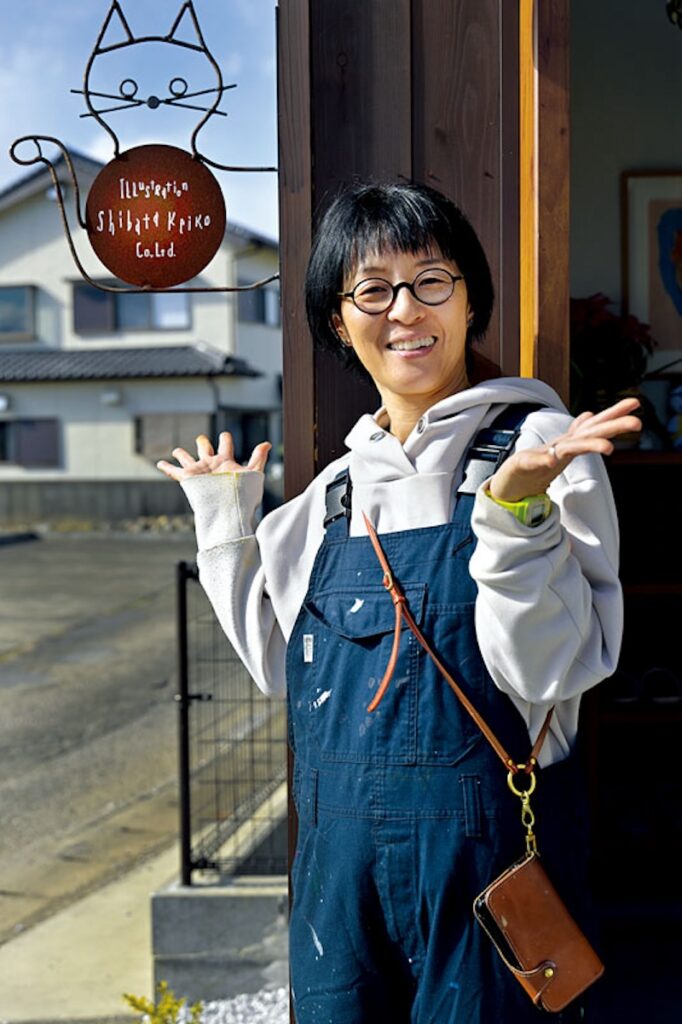
The first book in The Bread Thief series was published in April 2020, and is about a loaf-shaped master thief who searches for delicious bread. One day, he sneaks into a bakery he finds in the woods and can’t help stealing a loaf of bread. “My old business card featured an illustration of a polar bear running away with a piece of bread on his head,” she says. “The editor liked the concept and thought it would be great if I could make a story out of it. On thinking about it, I realized I’d never heard anything about bread and thieves, so I thought I’d try my hand at making a book about it. That’s what triggered the story.” Four more instalments have come out in the last three years and they’ve all been bestsellers.
Shibata says that the reason she chooses those characters is because she loves drawing animals, and when she creates them, she wants them to be very human-like, but not particularly cute like they came out of a Disney cartoon. “If you look at Meganeko, for example, you notice that he looks more like an old man with glasses,” she says.
Shibata’s success has given her the opportunity to branch out and extend her production in many directions, from collage to textile and packaging design. Every year, she even produces giant ema (votive tablets) for Sugimoto Shrine in Ino, each one devoted to one of the 12 signs of the Chinese zodiac. Still, after 20 years of working as an illustrator and six as an author, Shibata says that her approach hasn’t changed much. “At first you imitate other people you admire, then you realize that you like a particular genre and are attracted to certain things rather than others, until you reach a point when you find what you really like. Myself, I used a process of elimination to figure out what I wanted to do, gradually whittling down what I didn’t need. From then on, the truly hard work started because I had to create my own style and original stories. I just kept changing and trying different ideas until I was satisfied. Even today, the basics haven’t changed, but I’m still looking for new ideas for engaging stories. I guess I’ve got the hang of my skills and try to use them as best as I can. In a sense, even now, after six years, I feel like I’m still a beginner.
“Creating illustrations for magazines, advertisements, etc., is quite another thing, of course. My current style and working method are completely different from when I first started. Before I had a child, I often drew pictures of fashionable girls. Then I became a mother and began to draw cute, slightly more child-like figures. Also, as you can imagine, an illustrator’s work depends on the client’s needs, so it changes slightly every time. You have to adapt your style to their requirements.
“That’s the big difference between illustrations and picture books. Illustrations are made for commercial purposes, so I have to draw according to the client’s wishes, but making a book is a chance to express myself, so I can write and draw whatever I want according to my poetic world. I hope the readers will be happy with what I’ve done. That’s what’s so interesting about it, and also what makes it so difficult. But at the end of the day, I don’t want to put out a book unless I’m truly satisfied. My editors don’t always agree with me, and there are times when my ideas are rejected, but that’s all part of the game. In the end, I want people to enjoy picture books as a communication tool for parents and children.”
Gianni Simone
To learn more on this topic , check out our other articles :
N°138 [FOCUS] Battling to attract people
N°138 [NEWS] A tribute to local newspapers
N°138 [TRAVEL] A wealth f beauty
N°138 [ZOOM GOURMAND] Yuzu today, yuzu forever
Follow us !

